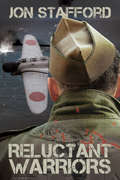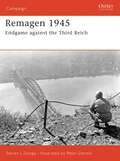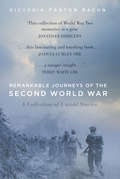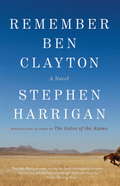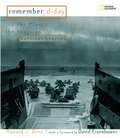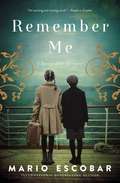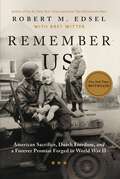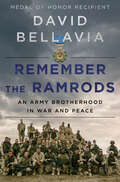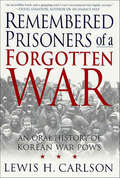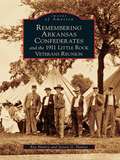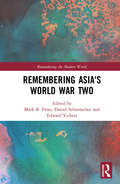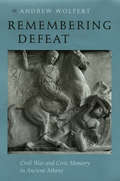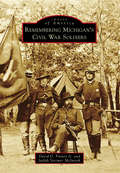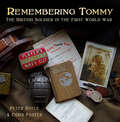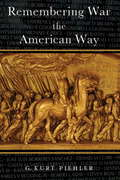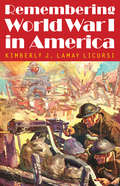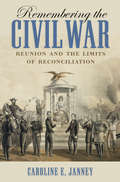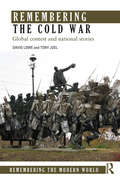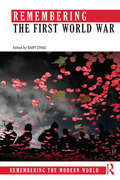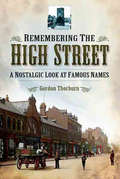- Table View
- List View
Reluctant Warriors (Reluctant Warriors Ser. #1)
by Jon StaffordThe soldiers of World War II were ordinary men who found themselves in extraordinary circumstances. Unable to ignore their obligations to their country and to the world, these men bravely faced combat. Many of them never sought reward or accolades, but simply returned from war, forever changed and forever humbled by the tenuous balance of life and death. Each of the men depicted here---Joseph "Chip" Wiley, Jimmy DeValery, Harry Conners, and Theodore Rodgers---had lives, families, and careers they left behind. But they were not the only ones to report for duty: their families also had to fight daily battles through hardships, through defeats, through loss. This book recounts their stories. Men, women, husbands, wives, sisters, brothers, and children: all reluctant warriors, rising to the incredible challenge of wars fought on every front.
Remagen 1945
by Peter Dennis Steven ZalogaFollowing the Battle of the Bulge in the Ardennes, the Allies began steps for the final assault into Germany. The long-delayed US Army thrust over the Roer River, Operation Lumberjack, finally took place in February, placing the US Army along the Rhine. The Rhine represented the last major geographical barrier to the Allied advance into Germany. The plan was for Montgomery's 21st Army Group to leap the Rhine into the Ruhr in a carefully choreographed attack called Operation Plunder. In the event, fortune smiled on the US Army when the 9th Armored unexpectedly found that the Ludendorff bridge at Remagen had not yet been demolished by the Wehrmacht, leaving this one major crossing over the Rhine intact. An armored infantry team supported by the new Pershing tanks stormed the bridge, seized it in fierce fighting and disarmed the charges placed on it. They then held it against numerous counterattacks in which the Germans used conventional tactics and unconventional, including jet bombers, V-2 missiles, and frogmen. Remagen was not the only impromptu Rhine crossing made by the US Army in central Germany but it was the most dramatic and hardest fought. The irrepressible George Patton, in spite of instructions to stay put, snuck an infantry division across the Rhine in the south, setting the stage for the race into Germany. After reinforcing their two major Rhine crossings, the US Army launched its late-March offensive, encircling Frankfurt, and setting the stage for the defeat of the Wehrmacht in the West. This is a gripping, authoritative account of a crucial battle during the last major set-piece operation of World War II (1939-1945).
Remarkable Journeys of the Second World War: A Collection of Untold Stories
by Victoria Panton BaconThose who lived through the Second World War have many stories of bravery, sadness, horror, doubt and longing. Inspired by conversations with a wide range of veterans following the publication of her grandfather’s wartime memoir, Victoria Panton Bacon has gathered a moving collection of their experiences. Their recollections tell of a different time and reveal the courage, actions and sentiments of those whose wartime experiences changed the course of history; stories of ordinary people who lived under the long shadows cast by the war and whose young lives were changed irrevocably. Though many tales are sad, describing being sent into war and the loss of friends and family, there are also stories of joy and love found in the darkest of times. For them, war, the ultimate leveller, threw them into remarkable times, whether they were a merchant seaman, army officer, pilot, young Jewish girl, code breaker or Home Guard recruit. From one extraordinary story to the next, Remarkable Journeys of the Second World War immerses the reader in the lives of real people who lived through conflict.
Remedies against Immunity?: Reconciling International and Domestic Law after the Italian Constitutional Court’s Sentenza 238/2014 (Beiträge zum ausländischen öffentlichen Recht und Völkerrecht #297)
by Anne Peters Stefano Battini Valentina VolpeThe open access book examines the consequences of the Italian Constitutional Court’s Judgment 238/2014 which denied the German Republic’s immunity from civil jurisdiction over claims to reparations for Nazi crimes committed during World War II. This landmark decision created a range of currently unresolved legal problems and controversies which continue to burden the political and diplomatic relationship between Germany and Italy. The judgment has wide repercussions for core concepts of international law and for the relationship between different legal orders. The book’s three interlinked legal themes are state immunity, reparation for serious human rights violations and war crimes (including historical ones), and the interaction between international and domestic institutions, notably courts. Besides a meticulous legal analysis of these themes from the perspectives of international law, European law, and domestic law, the book contributes to the civic debate on the issue of war crimes and reparation for the victims of armed conflict. It proposes concrete legal and political solutions to the parties involved for overcoming the present paralysis with a view to a sustainable interstate conflict solution and helps judges directly involved in the pending post-Sentenza reparation cases. After an Introduction (Part I), Part II, Immunity, investigates core international law concepts such as those of pre/post-judgment immunity and international state responsibility. Part III, Remedies, examines the tension between state immunity and the right to remedy and suggests original schemes for solving the conundrum under international law. Part IV adds European Perspectives by showcasing relevant regional examples of legal cooperation and judicial dialogue. Part V, Courts, addresses questions on the role of judges in the areas of immunity and human rights at both the national and international level. Part VI, Negotiations, suggests concrete ways out of the impasse with a forward-looking aspiration. In Part VII, The Past and Future of Remedies, a sitting judge in the Court that decided Sentenza 238/2014 adds some critical reflections on the Judgment. Joseph H. H. Weiler’s Dialogical Epilogue concludes the volume by placing the main findings of the book in a wider European and international law perspective.
Remember Ben Clayton
by Stephen HarriganFrom the author of the acclaimed best seller The Gates of the Alamo, a new novel that confirms and enlarges Stephen Harrigan's reputation as a major voice in American fiction.Francis "Gil" Gilheaney is a sculptor of boundless ambition. But bad fortune and his own prideful spirit have driven him from New York into artistic exile in Texas just after World War I. His adult daughter, Maureen, serves as his assistant, although she has artistic ambitions of her own and is beginning to understand how her own career--perhaps even her life--has become hostage to her driven father's "wild pursuit of glory." When Lamar Clayton, an aging, heartbroken rancher, offers Gil a commission to create a memorial statue of his son Ben, who was killed in the war, Gil seizes the opportunity to create what he believes will be his greatest achievement.As work proceeds on the statue, Gil and Maureen come to realize that their new client is a far more complicated man than he appeared to be on first acquaintance, and that Lamar is guarding a secret that haunts his relationship with his son even in death. But Gil is haunted as well: by the fear that his work will be forgotten and by an unconscionable lie whose discovery could cost him his daughter's love. The creation of the statue leads to a chain of dramatic encounters, through which Maureen will test the boundaries of her independence and Gil and Lamar, each in his own painful way, will confront their worth as fathers. Remember Ben Clayton vividly depicts a rich swath of American history, from the days when the Comanches ruled the Southern plains to the final brutal months of World War I. It ranges from outlaw settlements on the Texas frontier to the cafés of Paris, from Indian encampments to artists' ateliers to the forgotten battlefield in France where Ben Clayton died. It shows us the all-consuming labor that a monumental work of sculpture demands and the price it exacts from both artist and patron. And with unforgettable power and compassion it presents a deeply moving story about the bonds between fathers and children, and about the power and purpose of art.From the Hardcover edition.
Remember D-Day: The Plan, the Invasion, Survivor Stories
by Ronald J. DrezRemember D-Day combines compelling narrative, dramatic archival photographs and memorabilia, detailed maps, and a timeline to bring readers the exciting story of one of the world's most daring invasions. This landmark book will provide children with valuable insight into the significance of the invasion and help them understand D-Day in the overall context of the war.
Remember Me
by Trezza AzzopardiThe narrator of this novel, set in an English village, is known by many names. To her father she is Patsy; to her grandfather she is Lillian; to her lover she is Beauty; and later, as a clairvoyant on the stage, she is known as Winifred Foy. Through a long series of losses, abandonments, and betrayals, one identity flows into another. The narrator is an outsider, living among outsiders. Throughout her troubled life she holds onto memories of the people who mattered to her and clings to slivers of hope.
Remember Me \ Recuerdame (Spanish edition): El barco que salvó a quinientos ninos republicanos de la Guerra Civil Espanola
by Mario EscobarUna novela emocionante, tremendamente humana e inspirada en hechos reales, que describe las peripecias de un grupo de niños en un plena Guerra Civil Española y su viaje a México, donde recibieron la ayuda del presidente General Cárdenas del Río.Marco, Isabel y Ana viven en Madrid, corre el año 1937 y a pesar de la llegada de la primavera, la ciudad sufre continuos bombardeos y está a punto de rendirse ante las tropas del general Franco. Los padres de los niños se debaten entre la duda de sacar a sus hijos de la ciudad o mantener a la familia unida. Francisco, el padre, se entera de que el presidente Manuel Azaña está organizando la evacuación de casi medio millar de niños con la colaboración del Comité Iberoamericano de ayuda a los niños del Pueblo Español y piensa en enviarlos lejos. En el camino vivirán la aventura de sus vidas y se enfrentarán al peligro de la guerra y la dura separación de sus padres, con los que se comprometen a no olvidarlos jamás.Un viaje a través de la historia del siglo XX de la mano de unos personajes inolvidables que descubrirán el poder del amor, la amistad y que, a veces, lo difícil no es huir sino volver a casa.
Remember Me: A Spanish Civil War Novel
by Mario EscobarAmid the shadows of war, one family faces an impossible choice that will change their lives forever. Madrid, 1934. Though the Spanish Civil War has not yet begun, the streets of Madrid have become dangerous for thirteen-year-old Marco Alcalde and his younger sisters, Isabel and Ana. When Marco&’s parents align themselves against General Franco and his fascist regime, they have no inkling that their ideals will endanger them and everyone they love—nor do they predict the violence that is to come.When the Mexican government promises protection to the imperiled children of Spain, the Alcaldes do what they believe is best: send their children, unaccompanied, across the ocean to the city of Morelia—a place they&’ve never seen or imagined. Marco promises to look after his sisters in Mexico until their family can be reunited in Spain, but what ensues is a harrowing journey and a series of heartbreaking events. As the growing children work to care for themselves and each other, they feel their sense of home, family, and identity slipping further and further away. And as their memories of Spain fade and the news from abroad grows more grim, they begin to wonder if they will ever see their parents again or the glittering streets of the home they once loved.Based upon the true stories of the Children of Morelia, Mario Escobar&’s Remember Me—now available for the first time in English—explores the agony of war and paints a poignant portrait of one family&’s sacrificial love and endurance.
Remember Us: American Sacrifice, Dutch Freedom, and A Forever Promise Forged in World War II
by Robert M. Edsel<b>NEW YORK TIMES BESTSELLER</b> <P> “An intimate, moving look at the war that extracts deep meaning from the carnage and loss.” – Publishers Weekly <P> What happens when you lose your freedom and the people who eventually get it back for you are no longer alive to thank? Remember Us, by Robert Edsel—#1 New York Times bestselling author of The Monuments Men—begins in the pre-dawn hours of Hitler’s invasion of Western Europe on May 10, 1940, when his forces rolled into the small rural province of Limburg in the Netherlands shattering more than 100 years of peace. Their freedom gone, the Dutch lived through four-and-a-half years of occupation until American forces reached Limburg in September 1944, the last portion of Western Europe liberated by the Allies before their advance on Nazi Germany slammed to a halt. <P> Like The Monuments Men, Remember Us is an ensemble piece that follows twelve main characters over a six-year span, zeroing in on ordinary people including Frieda van Schäik, a teenager who falls in love with an American soldier; Lieutenant Colonel Robert Cole, the first member of the 101st Airborne to receive the Medal of Honor; and Sergeant Jeff Wiggins of the 960th Quartermaster Service Company, who escaped the poverty and racism of Alabama for yet another indignity—digging graves. <P> Drawing on never-before-seen letters, diaries, and other historical records, Edsel shows the painful price of freedom, on the battlefields and inside American homes. In this rich, dramatic, and suspenseful story, he captures both the horrors of war and the transcendent power of gratitude, showing the extraordinary measures the Dutch have taken to thank their liberators. Remember Us is exactly the book we need—a reminder that grief is universal, that humanity knows no national or racial boundaries, and that we all want to be remembered, somehow, someway, by somebody.
Remember the Ramrods: An Army Brotherhood in War and Peace
by David BellaviaThe Iraq War’s only living Medal of Honor recipient reveals the untold story of the remarkable brotherhood behind one of the Iraq War’s legendary acts of valor In 2004, he stormed an enemy stronghold to save his platoon. Fourteen years later, his unit reunited and saved him. This is their story.“Acting on instinct to save the members of his platoon from an imminent threat, Staff Sergeant Bellavia ultimately cleared an entire enemy-filled house.” So reads the Medal of Honor citation describing one of the Iraq War’s most celebrated acts of heroism. But the full story of the brotherhood at the heart of these events is untold—and far more remarkable.In 2004, David Bellavia’s U.S. Army unit, an infantry battalion known as the Ramrods—2nd Battalion, 2nd Infantry Regiment, 1st Infantry Division—fought and helped win the Battle of Fallujah, the bloodiest episode of the Iraq War. On November 10, 2004, Bellavia single-handedly cleared a fortified enemy position that had pinned down a squad from his platoon. Fourteen years later, Bellavia got a call from the president of the United States: he had been awarded a Medal of Honor for his actions in Fallujah and would receive America’s highest award for bravery in combat during a ceremony at the White House.The news was not welcome. Bellavia had put the war behind him, created a quiet life for himself in rural western New York, and lost touch with most of his fellow Ramrods, who were once like brothers to him. The first time they gathered as a unit after the war was at Bellavia’s medal ceremony, six days in Washington, D.C., that may have saved them all. As they revisited what they had seen and done in battle and revealed to one another their journeys back into civilian life, they discovered that the bonds had not been broken by time. A decoration for one became a healing event for all.This book—beginning in brutal war and ending with this momentous, transformative reunion—covers the journey of Bellavia’s platoon through fifteen years. A quintessential and timeless American tale, it is the story of how forty battle-hardened soldiers became ordinary citizens again; what they did during that time, and how November 10, 2004, rattled within them; and how their reunion brought them home at last.
Remembered Prisoners of a Forgotten War: An Oral History of Korean War POWs
by Lewis H. CarlsonRemembered Prisoners of a Forgotten War presents a devastating oral history of Korean War POWs.The Korean War POW remains the most maligned victim of all American wars. For nearly half a century, the media, general public, and even scholars have described hundreds of these prisoners as "brainwashed" victims who uncharacteristically caved in to their Communist captors or, even worse, as turncoats who betrayed their fellow soldiers. In either case, these boys apparently lacked the "right stuff" required of our brave sons.Here, at long last, is a chance to hear the true story of these courageous men in their own words-- a story that, until now, has gone largely untold. Dr. Carlson debunks many of the popular myths of Korean War POWs in this devastating oral history that's as compelling and moving as it is informative. From the Tiger Death March to the paranoia here at home, Korean POWs suffered injustices on a scale few can comprehend. More than 40 percent of the 7,140 Americans taken prisoner died in captivity, and as haunting tales of the survivors unfold, it becomes clear that the goal of these men was simply to survive under the most terrible conditions.Each survivor's story is a unique and personal experience, from missionary teacher Larry Zeller's imprisonment in the death cells of P'yongyang and his first encounter with the infamous killer known as The Tiger, to Rubin Townsend's daring escape from a death march by jumping off a bridge in a blinding snowstorm. From capture to forced marches, isolation, permanent camps, and torture, Remembered Prisoners of a Forgotten War is one of the most fascinating and disturbing books on the Korean War in years-- and a brutally honest account of the Korean POW experience, in the survivors' own words.
Remembering 1916
by Richard S. Grayson Grayson, Richard S. and McGarry, Fearghal Fearghal McgarryThe year 1916 witnessed two events that would profoundly shape both politics and commemoration in Ireland over the course of the following century. Although the Easter Rising and the Battle of the Somme were important historical events in their own right, their significance also lay in how they came to be understood as iconic moments in the emergence of Northern Ireland and the Irish Republic. Adopting an interdisciplinary approach drawing on history, politics, anthropology and cultural studies, this volume explores how the memory of these two foundational events has been constructed, mythologised and revised over the course of the past century. The aim is not merely to understand how the Rising and the Somme came to exert a central place in how the past is viewed in Ireland, but to explore wider questions about the relationship between history, commemoration and memory.
Remembering Arkansas Confederates and the 1911 Little Rock Veterans Reunion (Images of America)
by Ray Hanley Steven G. HanleyArkansas seceded from the Union in 1861, opening a chapter in the state's history that would change its destiny for decades. An estimated 6,862 Arkansas Confederate soldiers died from battle and disease, while some 1,700 Arkansas men died wearing Union blue. Total casualties, killed and wounded, represented 12 percent of the white men in the state between the ages of 15 and 62. Bloody, hard-fought battles included Pea Ridge, Helena, Little Rock, and the rare Confederate victory in southwest Arkansas at Jenkins' Ferry. Following the war, the event that included the largest parade ever in Arkansas, the 1911 United Confederate Veterans Reunion, is presented in picture and word. The event has largely been neglected by history books. From the monuments and veterans to the loyal reenactors still gathering today, the story of the Civil War in Arkansas is remembered and preserved for coming generations.
Remembering Asia's World War Two (Remembering the Modern World)
by Edward Vickers Mark R. Frost Daniel SchumacherOver the past four decades, East and Southeast Asia have seen a proliferation of heritage sites and remembrance practices which commemorate the region’s bloody conflicts of the period 1931–45. Remembering Asia’s World War Two examines the origins, dynamics, and repercussions of this regional war “memory boom”. The book analyzes the politics of war commemoration in contemporary East and Southeast Asia. Featuring contributions from leading international scholars, the chapters span China, Japan, Malaysia, Hong Kong, and Singapore, covering topics such as the commemoration of the Japanese military’s “comfort women” system, forms of "dark tourism" or commemorative pilgrimages (e.g. veterans’ tours to wartime battlefields), and the establishment and evolution of various war-related heritage sites and museums. Case studies reveal the distinctive trajectories of new and newly discovered forms of remembrance within and across national boundaries. They highlight the growing influence of non-state actors over representations of conflict and occupation, as well as the increasingly interconnected and transnational character of memory-making. Taken together, the studies collected here demonstrate that across much of Asia the public commemoration of the wars of 1931–45 has begun to shift from portraying them as a series of national conflicts with distinctive local meanings to commemorating the conflict as a common pan-Asian, or even global, experience. Focusing on non-textual vehicles for public commemoration and considering both the local and international dimensions of war commemoration within, Remembering Asia’s World War Two will be a crucial reference for students and scholars of History, Memory Studies, and Heritage Studies, as well as all those interested in the history, politics, and culture of contemporary Asia.
Remembering Defeat: Civil War and Civic Memory in Ancient Athens
by Andrew WolpertIn 404 b.c. the Peloponnesian War finally came to an end, when the Athenians, starved into submission, were forced to accept Sparta's terms of surrender. Shortly afterwards a group of thirty conspirators, with Spartan backing ("the Thirty"), overthrew the democracy and established a narrow oligarchy. Although the oligarchs were in power for only thirteen months, they killed more than 5 percent of the citizenry and terrorized the rest by confiscating the property of some and banishing many others. Despite this brutality, members of the democratic resistance movement that regained control of Athens came to terms with the oligarchs and agreed to an amnesty that protected collaborators from prosecution for all but the most severe crimes. The war and subsequent reconciliation of Athenian society has been a rich field for historians of ancient Greece. From a rhetorical and ideological standpoint, this period is unique because of the extraordinary lengths to which the Athenians went to maintain peace. In Remembering Defeat, Andrew Wolpert claims that the peace was "negotiated and constructed in civic discourse" and not imposed upon the populace. Rather than explaining why the reconciliation was successful, as a way of shedding light on changes in Athenian ideology Wolpert uses public speeches of the early fourth century to consider how the Athenians confronted the troubling memories of defeat and civil war, and how they explained to themselves an agreement that allowed the conspirators and their collaborators to go unpunished. Encompassing rhetorical analysis, trauma studies, and recent scholarship on identity, memory, and law, Wolpert's study sheds new light on a pivotal period in Athens' history.
Remembering Manzanar: Life in a Japanese Relocation Camp
by Michael L. CooperUses first-hand accounts, oral histories, and essays from school newspapers and yearbooks to tell the story of the Japanese Americans who were sent to live in government-run internment camps during World War II. Includes bibliographical references and index.
Remembering Michigan's Civil War Soldiers (Images of America)
by Judith Stermer Mcintosh David D. Finney Jr.When the 1st Michigan Volunteer Infantry regiment arrived in Washington, DC, President Lincoln exclaimed: "Thank God for Michigan!" The state raised more than 90,000 men to serve during the Civil War, and 69 of them received the Medal of Honor. Notable Michiganders include Gens. Israel Richardson, Orlando Poe, Alpheus Williams, Orlando Willcox, and George Hartsuff, as well as "The Boy General," George Armstrong Custer, and Officer Norman Hall, who was stationed at Fort Sumter when the war began. Featuring images of the 4th Michigan Cavalry, which captured Confederate president Jefferson Davis at the war's end, and never-before-published photographs of Wolverine soldiers, Images of America: Remembering Michigan's Civil War Soldiers highlights hundreds of Michiganians who were committed to preserving the Union.
Remembering Tommy: The British Soldier in the First World War
by Peter Doyle Chris FosterThe British soldier of the Great War has been depicted in many books. Invariably, a pen picture paints him as stoic, joining the army in a wave of patriotic fervour, and destined to serve four years on the Western Front in some of the most costly battles in history. Yet often the picture is difficult to resolve for the reader. What was it like in the trenches? How did the soldier live, where did he sleep? What was it like to go over the top, and when he did, what did he carry with him? For many, the idea of trench life is hazy, and usually involves ‘drowning in mud’, in, as one writer put it, ‘the pitiless misery’ of Passchendaele. Recently, military historians have presented an alternative picture, a picture in which the hopelessness of the First World War is given new life and purpose. Remembering Tommy pays tribute to the real life British soldier of the Great War from the moment of joining up to their final homecoming. Using original artefacts in historic settings, the men and their words are brought to life. The uniforms they wore, the equipment they carried, the letters they wrote home, their personal possessions, mementos and photographs come together in a powerful tribute to the indomitable Tommy. Each one of these precious artefacts bears witness to the men who left them behind – allowing us to almost reach out and touch history.
Remembering War the American Way
by G. Kurt PiehlerWars do not fully end when the shooting stops. As G. Kurt Piehler reveals in this book, after every conflict from the Revolution to the Persian Gulf War, Americans have argued about how and for what deeds and heroes wars should be remembered.Drawing on sources ranging from government documents to Embalmer's Monthly, Piehler recounts efforts to commemorate wars by erecting monuments, designating holidays, forming veterans' organizations, and establishing national cemetaries. The federal government, he contends, initially sidestepped funding for memorials, thereby leaving the determination of how and whom to honor in the hands of those with ready money--and those who responded to them. In one instance, monuments to "Yankee heroes" erected by the Daughters of the American Revolution were countered by immigrant groups, who added such figures as Casimir Pulaski and Thaddeus Kosciusko to the record of the war. Piehler argues that the conflict between these groups is emblematic of the ongoing reinterpretation of wars by majority and minority groups, and by successive generations.Demonstrating that the battles over the Vietnam Veterans Memorial are not unique in American history, Remembering War the American Way reveals that the memory of war is intrinsically bound to the pluralistic definition of national identity.
Remembering World War I in America (Studies in War, Society, and the Military)
by Kimberly J. Lamay LicursiPoised to become a significant player in the new world order, the United States truly came of age during and after World War I. Yet many Americans think of the Great War simply as a precursor to World War II. Americans, including veterans, hastened to put experiences and memories of the war years behind them, reflecting a general apathy about the war that had developed during the 1920s and 1930s and never abated. In Remembering World War I in America Kimberly J. Lamay Licursi explores the American public’s collective memory and common perception of World War I by analyzing the extent to which it was expressed through the production of cultural artifacts related to the war. Through the analysis of four vectors of memory—war histories, memoirs, fiction, and film—Lamay Licursi shows that no consistent image or message about the war ever arose that resonated with a significant segment of the American population. Not many war histories materialized, war memoirs did not capture the public’s attention, and war novels and films presented a fictional war that either bore little resemblance to the doughboys’ experience or offered discordant views about what the war meant. In the end Americans emerged from the interwar years with limited pockets of public memory about the war that never found compromise in a dominant myth.
Remembering the Civil War
by Caroline E. JanneyAs early as 1865, survivors of the Civil War were acutely aware that people were purposefully shaping what would be remembered about the war and what would be omitted from the historical record. In Remembering the Civil War, Caroline E. Janney examines how the war generation--men and women, black and white, Unionists and Confederates--crafted and protected their memories of the nation's greatest conflict. Janney maintains that the participants never fully embraced the reconciliation so famously represented in handshakes across stone walls. Instead, both Union and Confederate veterans, and most especially their respective women's organizations, clung tenaciously to their own causes well into the twentieth century. Janney explores the subtle yet important differences between reunion and reconciliation and argues that the Unionist and Emancipationist memories of the war never completely gave way to the story Confederates told. She challenges the idea that white northerners and southerners salved their war wounds through shared ideas about race and shows that debates about slavery often proved to be among the most powerful obstacles to reconciliation.
Remembering the Cold War: Global Contest and National Stories (Remembering the Modern World)
by David Lowe Tony JoelRemembering the Cold War examines how, more than two decades since the collapse of the Soviet Union, Cold War legacies continue to play crucial roles in defining national identities and shaping international relations around the globe. Given the Cold War’s blurred definition – it has neither a widely accepted commencement date nor unanimous conclusion - what is to be remembered? This book illustrates that there is, in fact, a huge body of ‘remembrance,’ and that it is more pertinent to ask: what should be included and what can be overlooked? Over five sections, this richly illustrated volume considers case studies of Cold War remembering from different parts of the world, and engages with growing theorisation in the field of memory studies, specifically in relation to war. David Lowe and Tony Joel afford careful consideration to agencies that identify with being ‘victims’ of the Cold War. In addition, the concept of arenas of articulation, which envelops the myriad spaces in which the remembering, commemorating, memorialising, and even revising of Cold War history takes place, is given prominence.
Remembering the First World War (Remembering the Modern World)
by Bart ZiinoRemembering the First World War brings together a group of international scholars to understand how and why the past quarter of a century has witnessed such an extraordinary increase in global popular and academic interest in the First World War, both as an event and in the ways it is remembered. The book discusses this phenomenon across three key areas. The first section looks at family history, genealogy and the First World War, seeking to understand the power of family history in shaping and reshaping remembrance of the War at the smallest levels, as well as popular media and the continuing role of the state and its agencies. The second part discusses practices of remembering and the more public forms of representation and negotiation through film, literature, museums, monuments and heritage sites, focusing on agency in representing and remembering war. The third section covers the return of the War and the increasing determination among individuals to acknowledge and participate in public rituals of remembrance with their own contemporary politics. What, for instance, does it mean to wear a poppy on armistice/remembrance day? How do symbols like this operate today? These chapters will investigate these aspects through a series of case studies. Placing remembrance of the First World War in its longer historical and broader transnational context and including illustrations and an afterword by Professor David Reynolds, this is the ideal book for all those interested in the history of the Great War and its aftermath.
Remembering the High Street: A Nostalgic Look at Famous Names
by Gordon ThorburnA nostalgic trip down the British high street, remembering once famous names such as Woolworths, Athena and C&A and also featuring current favorites, including the ubiquitous Tesco and Marks & Spencer which started life as a penny market stall to become a retail giant that has had to adapt to survive. Full of fact boxes and quirky facts about much-loved shops and the people behind them just who was W.H. Smith and what did those famous initials stand for? A fascinating book which charts the rise and, in too many cases, fall of our favorite shops.There used to be butcher, baker, grocer, greengrocer, draper, Boots, ironmonger (hardware), pub, WH Smith, cafe, bank, Freeman Hardy and Willis, jeweler, Marks and Spencer, furniture shop, hotel, bookseller, off license, haberdasher, Woolworth's, confectioner, cobbler, tobacconist, electrical showroom, Burton's, gas showroom, ladies' fashions, gentlemen's outfitters, and more, and maybe a department store, and several versions of some. What do we have now? Pound shop, charity (thrift) shop, building society branch, betting shop, coffee shop, charity shop, shop boarded up, building society branch, sandwich shop, shop boarded up, kebab takeaway, charity shop, card shop, Indian takeaway, mobile phone shop - we exaggerate but make the point. So what has gone wrong - if it is wrong? The author discusses these and many other topics, and answers hundreds of burning questions. Whatever happened to the Home and Colonial, Timothy White's, Lipton's, the District Bank, the Fifty Shilling Tailor? Who were Jesse Boot, Montague Burton, W H Smith? How did the Co-op start? Whatever happened to all those things we used to buy in those shops in the high street - Balkan Sobranie, Caley Tray, Oxydol, Phillips Stick-a-soles, Icilma Cream, Mansion Polish, Mrs Peek's Puddings? Does any girl still dream of going to work in her Maidenform bra?
